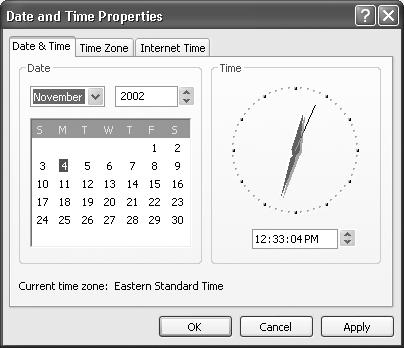Date and Time
Your PC’s conception of what time it is can be very important. Every file you create or save is stamped with this time, and every email you send or receive is marked with it. When you drag a document into a folder that contains a different draft of the same thing, Windows warns that you’re about to replace an older version with a newer one (or vice versa)—but only if your clock is set correctly.
Tip
Double-clicking the time in the taskbar notification area (or right-clicking the time and then selecting Properties from the shortcut menu) also displays the Date and Time Properties dialog box. Upon first examination, only two of the three tabs show up: the Date & Time and the Time Zone tabs. If you let the dialog box remain open on the desktop for a few seconds longer, however, the Internet Time tab will mysteriously make its appearance in the dialog box. (“Sorry I’m late. Did I miss anything?”)
This program offers three different tabs:
Date & Time. To set the date, choose the month and year from the drop-down lists, and then click the correct calendar day square. To set the time, see Figure 9-5.

Figure 9-5. To specify the current time, don’t bother dragging the hands of the clock—they’re just for decoration. Instead, click numbers in the time box, and then change it by typing numbers, pressing the up or down arrow keys on your keyboard, or by clicking the tiny up or down ...
Get Windows XP Professional: The Missing Manual now with the O’Reilly learning platform.
O’Reilly members experience books, live events, courses curated by job role, and more from O’Reilly and nearly 200 top publishers.

